
Focus on Native American Art: Lisa Forrest
Thursday, November 5, 2020
Lisa Forrest, a Cherokee artist, incorporates history into her basket weaving pieces— her family history and the history of her tribe. Her piece “Fall Gathering” will soon be displayed in the OSU College of Osteopathic Medicine at the Cherokee Nation.
The facility located in Tahlequah is the first tribally affiliated medical school site in the country. In addition to classrooms, clinical skills labs and a simulation center, the building will also house 125 pieces of Native American art.
Forrest’s piece that will be displayed at the medical school is made from honeysuckle reed, walnut dye, wild berries, dry grass, pinecones and leather.
For Forrest, the piece has both historical and personal significance.
“Historical because it is made of all-natural materials. It never felt right to mix the natural reed with anything commercial. Gathering was a natural part of the history of any tribe,” she said. “I’m always looking for things that I can use for basket making.”
Forrest said she likes to use honeysuckle, buck brush and things like nuts, berries, dried flowers, pinecones and corn husks for decorations. For the dyes she uses hickory nut hulls, blood root, wild cherry, elderberry and walnuts.
The piece is also personal because she learned how to make baskets from her mother, Cherokee National Treasure Lena Blackbird.
“I grew up watching my mother hand sew quilts and later she learned to make baskets and write poems. My father was also very artistic. He carved canes, bows, crawdad gigs and was able to draw a blueprint at a moment’s notice. He was known as ‘Mr. Fix-It’ so I’m sure that’s how I got interested in creating with my hands,” Forrest said.
Gina Olaya, director of Cultural Art & Design for Cherokee Nation Businesses, formed a committee of people from OSU Center for Health Sciences to select pieces submitted from Cherokee Nation artists to be showcased in the new building.
“It is my goal the students, faculty and staff learn about our Cherokee history, culture and heritage through visual art,” Olaya said.
Dr. Natasha Bray, D.O., associate dean of Academic Affairs, was one of the members of the art selection committee.
“We looked for pieces that provided an overall representation of the breadth of talent and medium used by Cherokee artists,” Bray said. “We wanted pieces that represented health, healing, medicine, wellness, family and community, but what we received was so much more.”
Dr. William Pettit, D.O, and dean of the OSUCOM at the Cherokee Nation said it’s important that the building reflect the history and culture of American Indian tribes in Oklahoma.
“This Native American artwork showcases the appreciation and respect that OSU Center for Health Sciences has for the culture and phenomenal partnership with the Cherokee Nation in developing the first tribally affiliated medical school in the United States,” Pettit said.
Forrest is proud that Native American art is being displayed in places like the new medical school site and other buildings that aren’t traditional museums and galleries.
"Not everyone will visit a museum where the art would be, so this gives more opportunities for people to view the art. I’m very happy and proud that something I made will be displayed in this way."
She thinks her mother will be proud too.
“What I enjoy about making baskets from natural reed is being able to continue the art that my mother enjoyed doing so much. She was so skilled at it and did it with crippled hands because of rheumatoid arthritis,” Forrest said. “She sees me working with the reed and I think she’s proud that her daughter enjoys it as much as she did.”
MEDIA CONTACT: Sara Plummer | Communications Coordinator | 918-561-1282 | sara.plummer@okstate.edu
